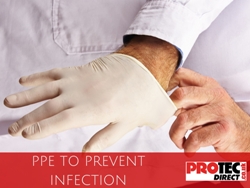The use of personal protective equipment as a means of preventing infection is perhaps more in the public eye at the moment than ever before.
In the midst of one of the worst viral outbreaks in living memory, and with the Ebola crisis threatening to get worse and spread in the coming months, it has never been more important to understand the role of PPE.
PPE in fighting Ebola
Those on the frontline of the fight against Ebola are having to take extreme precautions in order to prevent both infecting themselves and spreading the disease. They are therefore required to wear some very heavy duty and specific PPE. This includes an all over body suit, worn beneath a water and air-tight outer layer. Full face masks, additional goggles, two layers of gloves and protective boots cover every single bit of exposed skin. Although Ebola is not an airborne disease, it is spread through the exchange of bodily fluids, and this can involve rubbing exposed areas of skin in the eyes or transferral into the mouth.
As well as wearing this extensive PPE, the methods of application and especially removal are equally important. It is crucial that no part of the skin comes into contact with the outer layers of the protective gear when removing it. This is another key point of disease exchange. Once the PPE has been removed, it needs to be treated and cleaned with a sterile chlorine solution thoroughly before it can be used again. Those who are putting themselves at risk also have to shower and clean themselves and avoid rubbing their eyes or putting fingers near their mouths in order to reduce the risk of infection.
Although Ebola is a relatively hard disease to transfer if adequate risks are taken. The fact the disease is spreading so quickly highlights what happens when the correct PPE is not available. Other diseases that may be more easily transmitted through the air or proximity require similar levels of PPE.
In these instances it may be necessary to use more serious breathing apparatus, but similar standards about exposed skin and application and removal of PPE are required. Hospital staff, and in particular theatre and surgery staff, know the importance of using PPE to protect both themselves and the patients they are treating. These are lessons that have been learned over hundreds of years of infection, disease and death.
Ultimately, no form of PPE is 100% fool proof, as the small number of healthcare works who have contracted Ebola testifies. However, when used correctly and appropriately, it can significantly reduce the chances of infection. The effective management of risk is essentially the main purpose of any PPE.
All diseases and infection risks are different, so you need to assess the specific dangers in each infection risk area. Overlooking factors such as PPE boots or feet coverings can lead to the spread of infection, which as we are currently witnessing, can be extremely dangerous.
Hopefully, with an increased use of the correct PPE, the spread of Ebola can be halted before it gets any more serious. And, at the very least, hopefully we have all learned something about the importance of using PPE to prevent infection.





Leave a comment